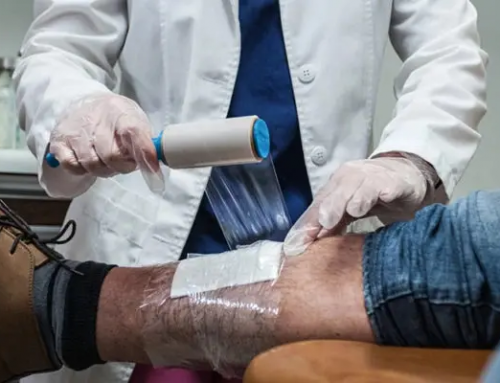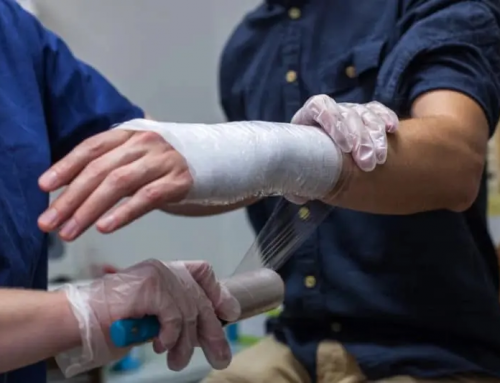A pressure ulcer is a serious skin injury. It occurs when the skin and underlying tissues of the skin break down due to inadequate blood supply, secondary to prolonged or constant pressure. This inadequate supply of nutrition or oxygen may progress to tissue necrosis or death of body tissue.
According to the Agency for Healthcare Research and Quality, it is estimated each year that around 60,000 patients die from complications of pressure ulcers, also termed decubitus ulcers by medical professionals. Several studies from various Wound Care Journals and Nursing Journals state a similar prevalence rate of mortality due to pressure ulcers.
Out-patient pressure ulcer
Pressure Ulcers can occur not only in patients in hospitals but to those who are confined to a bed at home and people who have mobility problems. Pressure ulcers may start to develop in as little as four hours. Primary care providers are responsible for periodically assessing individuals who are at-risk because pressure ulcers are often missed in outpatient settings.
How do you know if you or someone you love have a Pressure Ulcer?
Here are the most common signs and symptoms of pressure ulcers:
- An area of the skin that feels cooler or warmer to the touch compared to other areas
- Discharge or pus-like draining from an open wound
- Fever
- Foul smell of the affected area
- Redness or unusual changes in skin color or texture
- Swelling or signs of inflammation
- Tenderness
Depending on the severity of pressure ulcer, these signs and symptoms may differ. The degree of skin damage, including its depth and characteristics, is used to categorize pressure ulcers.
Common sites of Pressure Ulcers
For bedridden individuals, common locations of pressure ulcer include the following:
- Ankles
- Back of the head
- Heels
- Hip
- Lower back or buttocks
- Shoulder blades
- Sides of the head
- Tailbone
- The skin behind the knees
For those who use a wheelchair a lot, pressure ulcer usually occurs on the skin over the following areas:
- Backs of arms pressed against the chair
- Back of legs that rest against the chair
- Buttocks
- Shoulder blades
- Spine
- Tailbone
Caring for pressure ulcers
Because care for pressure ulcers is complex, various efforts to prevent the occurrence and exacerbation of the disease process necessitate an approach that involves proper management and the use of appropriate wound care devices.
Keep the skin clean and dry.
Pressure ulcers become infected when dirt or microorganisms invade the wound site. One way to avoid infection is to perform wound care regularly. Keep the skin clean and free from debris, such as dirt. You can use a gentle cleanser approved by your primary care provider and pat the skin dry. Do this regularly to avoid the skin’s exposure to urine, moisture, or stool.
Inspect the skin daily.
Pressure ulcers progress if not taken care of properly. To avoid complications and stop the progression of your pressure ulcer, check the skin daily for warning signs of a worsening pressure sore.
Protect the skin.
Use appropriate creams or solutions to protect the skin against friction points. It is important to change the bedding, clothing, or wound care dressings as frequently as needed. Also, try to avoid wrinkling of bed cover to prevent skin irritation.
Types of wound care dressings and creams
The good thing is that there are newer modalities of treatment. Creams, and wound dressings to care for most skin issues, including bed sores.
Antimicrobial cleaners
These are wound cleansers that inhibit the growth of bacteria.
Antifungal creams or solutions
If there are creams that prevent the growth of bacteria, there are also solutions and creams that inhibit fungal infections. They relieve skin irritation, itching, and burning. Some antifungal even contains ingredients that supply nutrients to the skin.
Skin repair cream
These are creams that help restore the natural moisture balance of the skin. Skin repair creams are perfect for those who are at risk for skin breakdown.
Pressure ulcer pads
A critical step in managing a pressure ulcer is reducing the pressure on the affected site. Pressure ulcer pads are perfect for this purpose. They reduce discomfort by relieving aches caused by excessive pressure on the bony prominence where pressure sore develops.
Pressure ulcer dressings
Pressure or pressure ulcer dressings keep the wound from becoming infected and help promote healing. Although some professionals prefer to keep the wound open to keep the wound site visible at all times, many wound care physicians recommend covering the pressure ulcer.
Wound dressings serve as the key element in wound care. They provide a protective barrier that protects the skin underneath it. Transparent wound dressings are the best, as they keep the wound visible without removing and reapplying the dressing.
SealSkin Medical Wrap and Pressure Ulcers
Sealskin is a transparent medical wrap that is stretchable and gentle to the skin or hair. Unlike traditional wound dressing and bandages, SealSkin is also waterproof. Depending on the category of your pressure sore, you can use SealSkin medical wrap as a dressing. It protects and secures while reducing the discomfort of the healing process.
With SealSkin, you won’t have to worry about buying wound dressing tapes, which usually comes off, especially if the pressure ulcer site is located in body parts that bend like elbows or ankles. It is also non-adhesive, so you won’t have to worry about removing tape adhesives.
Compared to other traditional medical wraps, SealSkin Medical Wrap keeps gauze bandages in place, facilitating a faster recovery process.





